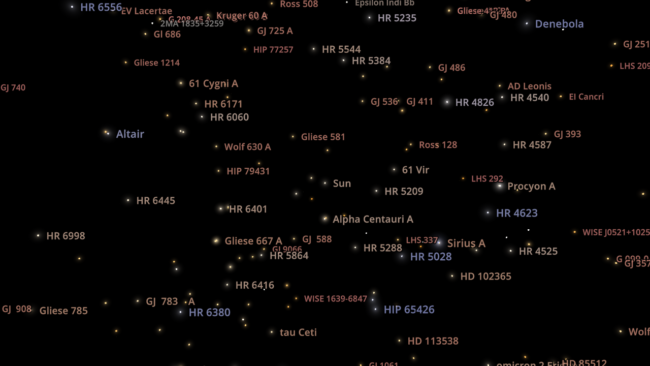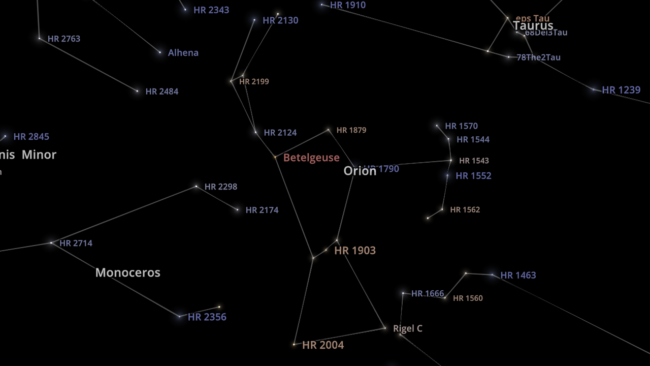Betelgeuse, Betelgeuse, BETELGEUSE: Naming Astronomical Objects


You’ve probably heard of the star Betelgeuse. It’s the second brightest star in the constellation Orion and made headlines in 2019 when it dimmed very quickly (don’t worry, it’s back to normal now). But have you heard of the star HR 2061? What about HIP 27989? You may not have heard of them, but they’re just different names for Betelgeuse!

Why do some astronomical objects have multiple names? Thousands of years ago, there were no rules for how to name them, and different cultures had different names for stars. Many familiar star names come from Arabic, including Betelgeuse, whose Arabic name (which was most likely Yad al-Jauzāʾ and translates to “the hand of al-Jauzā’”) references its position in the constellation Orion.

The Rules
Nowadays, humanity has observed billions of astronomical objects, and it would be very inconvenient to give them all individual names. Instead, astronomers follow a set of rules set by the International Astronomical Union (IAU), including
- Objects outside the Solar System are named using an acronym, which refers to the catalog name (such as “HIP” for the Hipparcos Catalog), followed by an identification number
- Dwarf planets beyond the orbit of Neptune are named after a deity or figure related to creation myths (like Makemake)
- Minor planets can be named by the person who discovered them after a formal review. If not named, minor planets are given only a sequential identification number. The ID number for the minor planet Mr. Spock (which you can find in Universe Sandbox) is 2309.
- Comets are named based on the type of comet (P for periodic, C for not-periodic), the year they were discovered, a letter for the half of the month they were discovered in (for example B for the second half of January), and then another number indicating the order of discovery. P/2005 S2 is a periodic comet discovered in 2005 that was the second comet discovered in the first half of October.
Hello, My Name Is Gaia DR2 4152993273702130432*
These rules, while complicated, make it much easier to reference objects in large catalogs, like the Yale Bright Star Catalog. This catalog, which is included in Universe Sandbox, contains 9,110 stars visible to the naked eye from Earth and uses the letters “HR” as a reference to its original name, the Harvard Revised Photometry Catalogue, which came out in 1908. Current space telescopes like Gaia have observed and cataloged over 1 billion astronomical objects, showing how valuable these naming rules are!
A Multitude of Names
The same objects are often part of multiple astronomical catalogs, with a different name for each catalog. Betelgeuse, for example, has 46 different names! While databases like SIMBAD collect these different names in one place, sorting through them can be difficult.

Universe Sandbox contains a database of over 45,000 known astronomical objects sourced from different catalogs, including the Open Exoplanet Catalog. While this is small compared to the billions of known astronomical objects, including all of them would make Universe Sandbox quite large (the Gaia catalog alone is over a terabyte of data).
If you want to find Betelgeuse in Universe Sandbox, you can search for Betelgeuse, HR 2061, or HIP 27989 and find it under the searched name. In the future, we plan to allow you to view all of the names that a star has in its properties, but for now, each object can only show one name at a time.

For now, try checking out some Solar System objects with interesting name origins in Universe Sandbox
- C/1906 E1 – The “C/” designates this as a non-periodic (only passes by the Sun once) comet. 1906 is the year of its discovery, and E1 means and was the first comet discovered in the first half of March (between March 1-15)
- Haumea – A dwarf planet named after the matron goddess of the island Hawai’i
- 2014 NW65 – A yet-unnamed minor planet. 2014 is the year of its discovery, N means it was discovered in the first half of July (between July 1-15), and W65 means it was the 1647 object found during that half month.
To join our community discussions, please join us on our Steam Forum and our official Discord community.
*Bonus Naming Rules: What is Gaia DR2 4152993273702130432?
Gaia DR2 4152993273702130432 is the designation for the star UY Scuti, one of the largest known stars, in the Second Data Release (DR2) of the Gaia catalog. Here “UY” doesn’t stand for a survey but instead follows a different set of IAU naming rules for variable stars. Scuti means that the star is located in the constellation Scutum, and UY indicates it was the 38th variable star discovered within this constellation.
Variable star labeling starts at R, S, etc., and goes through Z (9 labels total), then goes to RR through RZ (another 9 labels), then SS through SZ (8 more labels), until we get to ZZ. This is why UY is the 38th; 9 (R-Z) + 9 (RR-RZ) + 8 (SS-SZ) + 7 (TT-TZ) + 5 (UU-UY) = 38. Wow, this gets complicated quickly.
If more labels are needed, after going to ZZ, it starts over at AA going through AZ, then BB to BZ, and up to QQ through QZ for a total of 334 unique names for variable stars within a single constellation.


about 1 year ago
I already knew that there were some stars with other names but not as much unusual names as mentioned in this thread.